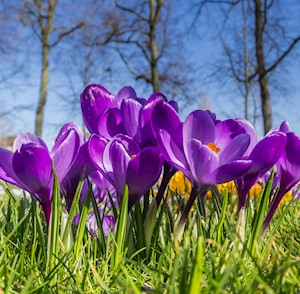 Crocuses are a fun way to add some early spring color to your lawn. They grow in purple and yellow colors.
Crocuses are a fun way to add some early spring color to your lawn. They grow in purple and yellow colors.
Venemama / iStock / Getty Images Plus
Which bulbs?
The most important step in growing bulbs in a lawn is picking types that are short, early to flower, good at coming back year after year, and unlikely to be eaten by deer, rabbits, squirrels, and other rodents.
Some of the best at that are snowdrops (Galanthus), crocuses (especially tommasinianus types or “Tommies”), squills (Scilla), early dwarf daffodils such as ‘Tete-e-Tete’ and ‘February Gold,’ (Narcissus), winter aconite (Eranthis), and glory-of-the-snow (Chionodoxa).
Planting bulbs in the lawn
For the most natural look, pick one type of bulb per area and plant handfuls of it by randomly tossing the bulbs and planting them where they fall. If you like more of a meadow look, buy several kinds of early, small bulbs and mix them together before tossing and planting.
The best sites to plant bulbs are full-sun lawns with good drainage. Bulbs often rot in compacted, soggy soil, and they won’t flower well in shade. The ideal time to plant is early fall – between late September and mid-November throughout most of the temperate United States.
Bulbs can be planted by slicing openings with a trowel, inserting the bulb, then tamping to close the slice. Or a bulb planter can be used to pull out cores of turf. After the bulb is inserted with the pointed end up into the hole, the core is returned and tamped back into place.
Plant bulbs about three times as deep as their height. An inch-tall crocus bulb, for example, would go three inches below the lawn surface. Water immediately after planting to settle the soil.
Caring for a bulbed lawn
The most important step in helping your lawn bulbs thrive is holding off mowing in spring at least until the bulb foliage has started to yellow. Cutting the bulb foliage while it’s still green reduces the bulb’s ability to take in sunlight and “recharge” the bulb for next year’s flowering.
Also, avoid using any herbicides on the lawn until the bulbs have gone completely dormant and died back. Supplemental fertilizer usually isn’t needed in reasonably healthy lawn soil. However, lawns that are treated with high-nitrogen fertilizers several times a year can lead to bulbs that leaf out well but don’t flower. If that happens, reduce nitrogen or scatter a granular bulb fertilizer over the area early each fall to help restore blooming.